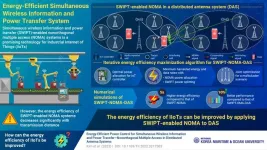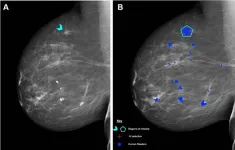(Press-News.org) Researchers at the University of California San Diego have developed a new type of material that could offer a sustainable and eco-friendly solution to clean pollutants from water.
Dubbed an “engineered living material,” it is a 3D-printed structure made of a seaweed-based polymer combined with bacteria that have been genetically engineered to produce an enzyme that transforms various organic pollutants into benign molecules. The bacteria were also engineered to self-destruct in the presence of a molecule called theophylline, which is often found in tea and chocolate. This offers a way to eliminate them after they have done their job.
The researchers describe the new decontaminating material in a paper published in the journal Nature Communications.
“What’s innovative is the pairing of a polymer material with a biological system to create a living material that can function and respond to stimuli in ways that regular synthetic materials cannot,” said Jon Pokorski, a professor of nanoengineering at UC San Diego who co-led the research.
The work was a collaboration among engineers, materials scientists and biologists at the UC San Diego Materials Research Science and Engineering Center (MRSEC). Co-principal investigators of the multidisciplinary team include molecular biology professors Susan Golden and James Golden and nanoengineering professor Shaochen Chen.
“This collaboration allowed us to apply our knowledge of the genetics and physiology of cyanobacteria to create a living material,” said Susan Golden, a faculty member in the School of Biological Sciences. “Now we can think creatively about engineering novel functions into cyanobacteria to make more useful products.”
To create the living material in this study, the researchers used alginate, a natural polymer derived from seaweed, hydrated it to make a gel and mixed it with a type of water-dwelling, photosynthetic bacteria known as cyanobacteria.
The mixture was fed into a 3D printer. After testing various 3D-printed geometries for their material, the researchers found that a grid-like structure was optimal for keeping the bacteria alive. The chosen shape has a high surface area to volume ratio, which places most of the cyanobacteria near the material’s surface to access nutrients, gases and light.
The increased surface area also makes the material more effective at decontamination.
As a proof-of-concept experiment, the researchers genetically engineered the cyanobacteria in their material to continually produce a decontaminating enzyme called laccase. Studies have shown that laccase can be used to neutralize a variety of organic pollutants including bisphenol A (BPA), antibiotics, pharmaceutical drugs and dyes. In this study, the researchers demonstrated that their material can be used to decontaminate the dye-based pollutant indigo carmine, which is a blue dye that is widely used in the textile industry to color denim. In tests, the material decolorized a water solution containing the dye.
The researchers also developed a way to eliminate the cyanobacteria after the pollutants have been cleared. They genetically engineered the bacteria to respond to a molecule called theophylline. The molecule triggers the bacteria to produce a protein that destroys their cells.
“The living material can act on the pollutant of interest, then a small molecule can be added afterwards to kill the bacteria,” said Pokorski. “This way, we can alleviate any concerns about having genetically modified bacteria lingering in the environment.”
A preferable solution, the researchers note, is to have the bacteria destroy themselves without the addition of chemicals. This will be one of the future directions of this research.
“Our goal is to make materials that respond to stimuli that are already present in the environment,” said Pokorski.
“We’re excited about the possibilities that this work can lead to, the exciting new materials we can create. This is the kind of research that can result when researchers with cross-disciplinary expertise in materials and biological sciences join forces. This is all made possible thanks to our interdisciplinary research group at the UC San Diego MRSEC.”
Paper title: “Phenotypically Complex Living Materials Containing Engineered Cyanobacteria.” Co-authors include Debika Datta*, Elliot L. Weiss*, Daniel Wangpraseurt, Erica Hild, Shaochen Chen, James W. Golden, Susan S. Golden and Jonathan K. Pokorski, all at UC San Diego.
*These authors contributed equally to this work.
This work was supported in part by the UC San Diego Materials Research Science and Engineering Center (UC San Diego MRSEC) and the National Science Foundation (DMR-2011924).
END
3D-printed ‘living material’ could clean up contaminated water
2023-09-05
ELSE PRESS RELEASES FROM THIS DATE:
KMOU scientists develop an energy-efficient wireless power and information transfer system
2023-09-05
Industrial Internet of Things (IIoTs) refers to a technology that combines wireless sensors, controllers, and mobile communication technologies to make every aspect of industrial production processes intelligent and efficient. Since IIoTs can involve several small battery-driven devices and sensors, there is a growing need to develop a robust network for data transmission and power transfer to monitor the IIoT environment.
In this regard, wireless power transfer is a promising technology. It utilizes radio frequency signals to power small devices that consume minimal power. Recently, simultaneous wireless information ...
ERC starting grants: 400 bright minds awarded over €628 million
2023-09-05
This funding, part of the EU’s Horizon Europe programme, will be invested in scientific projects spanning all disciplines of research. For example, a geochemist in the Netherlands will study Venus’ atmosphere to better understand habitability beyond Earth; a computer scientist in Germany seeks to make virtual reality more inclusive to physically disabled people; a geneticist in the UK aims to analyse parasites that cause malaria; and a researcher in Israel is set to investigate how algorithms are used at work to supervise employees.
ERC President Professor Maria Leptin said: “It is part of our mission to give early-career talent the independence to pursue ambitious ...
Dr. Niels Schröter wins ERC Starting Grant
2023-09-05
This is the first ERC Starting Grant to be hosted at the Max Planck Institute of Microstructure Physics. ChiralTopMat aims to provide the direct experimental observation of chiral spin-hedgehogs in structurally chiral crystals and to explore ways to control their properties for applications in magnetic memory devices. Moreover, another focus will be to test the stability of topological Berry curvature monopoles against strong electronic interactions that Schröter’s group recently discovered in a chiral topological semimetal, a material that combines structural ...
AI performs comparably to human readers of mammograms
2023-09-05
OAK BROOK, Ill. – Using a standardized assessment, researchers in the UK compared the performance of a commercially available artificial intelligence (AI) algorithm with human readers of screening mammograms. Results of their findings were published in Radiology, a journal of the Radiological Society of North America (RSNA).
Mammographic screening does not detect every breast cancer. False-positive interpretations can result in women without cancer undergoing unnecessary imaging and biopsy. To improve the sensitivity and specificity of ...
Perspective: Building megaprojects on time and under-budget
2023-09-05
A Perspective sheds light on why megaprojects take so long and cost so much—and what can be done to prevent the problem. Why did Boston’s “Big Dig” building project go 19 billion dollars over budget and take 9 years longer than anticipated? Globally, between $6 trillion and $9 trillion is spent on megaprojects every year, including everything from space telescopes to wind farms. In the United States, the recently passed $1 trillion infrastructure bill means a new era of megaprojects is at hand. In a Perspective, Guru Madhavan and colleagues review the causes behind ballooning costs and extended timelines for such megaprojects. Problems include premature ...
Can an artificial nose detect food spoilage?
2023-09-05
Researchers have developed an energy-efficient computing-based chip with smell-sensing units that can detect food spoilage and provides real-time conditions continuously throughout the spoilage process. The system is described in a study published in Advanced Science.
Other electronic noses, or artificial olfactory systems (AOSs), have been developed in the past, but they have numerous limitations, including high energy consumption, time delays, and data loss.
The AOS developed in this study requires little energy and integrates sensing and computing units on the same chip. It detects food spoilage by employing thin zinc oxide ...
Scammers can abuse security flaws in email forwarding to impersonate high-profile domains
2023-09-05
Sending an email with a forged address is easier than previously thought, due to flaws in the process that allows email forwarding, according to a research team led by computer scientists at the University of California San Diego.
The issues researchers uncovered have a broad impact, affecting the integrity of email sent from tens of thousands of domains, including those representing organizations in the U.S. government–such as the majority of U.S. cabinet email domains, including state.gov, ...
Experts propose new global definition of acute respiratory distress syndrome
2023-09-05
Sept. 5, 2023 – In a new report posted online in the American Journal of Respiratory and Critical Care Medicine, a global consensus conference of 32 critical care experts with broad international representation and from diverse backgrounds has proposed a new definition of acute respiratory distress syndrome (ARDS). In addition to the experts, critical care societies from around the world provided input, once they received feedback from their members. The report, which builds on the 2012 Berlin Definition of ARDS, will be published Jan. 1, 2024 in the American Thoracic Society’s AJRCCM.
ARDS is a life-threatening illness in which the lungs ...
Crowdsourcing contests: Understanding what brings high rewards, low risk
2023-09-05
AMES, IA – During Frito-Lay's first "Crash the Super Bowl" contest in 2006, thousands of participants submitted 30-second videos promoting Doritos. Entries were winnowed down to five finalists, and a public vote selected the winning commercial, which aired during the most watched American television broadcast of the year.
The ad boosted Doritos sales and pulled in awards, sparking other big brands, like Nestlé, BMW and Fisher-Price, to launch their own crowdsourcing contests.
"Crowdsourcing has become more prevalent over the last decade. It can generate innovative ideas and solutions and engage ...
Obesity experts spotlight safety gap in clinical trials and drug labeling for people with obesity
2023-09-05
A new opinion piece published in Health Affairs Forefront raises questions around current approaches to assess drug safety and effectiveness in people with obesity. The article sheds light on how increased body fat can modify the effects of drugs used to treat common conditions, in some cases rendering the drugs ineffective or unsafe for people with obesity.
The article, titled “Assessments Of Drug Safety And Effectiveness Continue To Fail People With Obesity,” argues that drug manufacturers should be required to show correct dosing instructions on their labels ...






